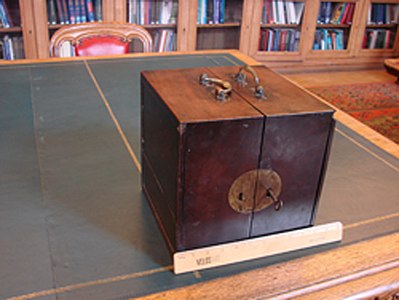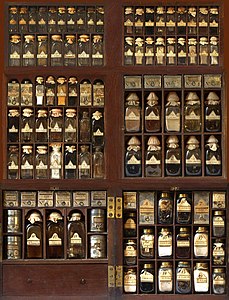Stuart Threipland
Sir Stuart Threipland MD, FRCPE | |
|---|---|
 Sir Stuart Threipland, de jure 3rd Baronet, of Fingask. Portrait by William Delacour | |
| Born | 18 May 1716 Perthshire, Scotland |
| Died | 1805 (aged 88–89) Edinburgh, Scotland |
| Medical career | |
| Profession | Physician-in-chief to Prince Charles Edward Stuart President Royal College of Physicians of Edinburgh |
Stuart Threipland
Early life
He was born in
Service in the 1745 Jacobite Rising
Threipland came from a staunchly Jacobite family, and his forename, spelt "Stuart", was a mark of the family's devotion to that cause.[3] When Prince Charles Edward Stuart raised his standard at Glenfinnan on 19 August 1745, he and his brother David joined his army. David Threipland died of a gunshot wound at the Battle of Prestonpans in September 1745.[3] Stuart Threipland remained with the prince throughout the campaign becoming his physician-in-chief.[4] He was with the Jacobite army as they marched south as far as Derby, remaining with them on the retreat north into Scotland, and he was present at the Battle of Culloden.[4] After the defeat at Culloden he went into hiding with the prince in the Highlands of Scotland. On one occasion they hid in a cave in Badenoch, where Threipland cared for another Jacobite fugitive and doctor Archibald Cameron of Locheil, who was later captured and hanged at Tyburn for his part in the rising. Assuming the disguise of a Presbyterian minister Threipland reached Edinburgh. There he changed his disguise to that of a printer's devil or apprentice and made his way to England. From there he escaped to France, where he joined Prince Charles Edward in exile in Paris.[2]

The cherubic figure to his right is thought to represent a 'guardian angel' which saved him from capture after the 1745 Jacobite Rising.
Later life
He was able to return to Scotland in 1747 or 1748 under the Act of Indemnity of 1747.[2] He resumed his practice as a physician in Edinburgh and was elected president of the Royal College of Physicians of Edinburgh on 4 December 1766.[3] When his father died in 1746 he became de jure the third baronet of Fingask but was technically unable to use the title during his lifetime. He lived at Fountain Close, close to the site of the first Hall of the Royal College of Physicians, and from 1771 in Chessel's Court in the Canongate. In later years he spent his summers at his villa at Moredun, south of Edinburgh and the winter months at his apartment in Horse Wynd, off the Canongate. Later he stayed at the Bishop's Land, a large dwelling in the High Street.[2] His practice was a successful one and enabled him in 1783 to buy back most of the family estates in Fingask and Kinnaird that had been confiscated in 1715.[2]
He died at Edinburgh in 1805.[3]
Family
He married his first wife, Janet Sinclair, in 1753, and after her death he married Janet Budge-Murray in 1761.[5] When Stuart Threipland died in 1805, Patrick, the eldest of their six children, inherited the baronetcy, and the title was formally restored in 1826 by Act of Parliament.[2]
Threipland's medicine chest
The
-
Threipland's medicine chest closed
-
Threipland's medicine chest opened showing drawers
-
Threipland's medicine chest opened showing compartments
-
Threipland's medicine chest fully opened showing all compartments
References
- ^ Scotland Births and Baptisms, 1564-1950. FamilySearch (https://familysearch.org/ark:/61903/1:1:VQW4-THV : 11 February 2020), Stuart Threipland, 1716.
- ^ S2CID 29695392.
- ^ PMID 21132152.
- ^ a b Whittet, M.M. (1964). "Medical resources of the Forty-five". Transactions of the Gaelic Society of Inverness. 44: 1–40.
- ^ Scotland Marriages, 1561-1910. FamilySearch (https://familysearch.org/ark:/61903/1:1:XYMF-1NP : 11 February 2020), Stuart Sir Threipland, 1761.; Scotland Marriages, 1561-1910. FamilySearch (https://familysearch.org/ark:/61903/1:1:XYMF-1JL : 11 February 2020), Stuart Baronet Thriepland, 1753.
- ^ PMID 23631007.
- ^ a b Worling, Peter (2013). "Sir Stuart Threipland's medicine chest: list 1" (PDF). Royal College of Physicians of Edinburgh.
- ^ a b Worling, Peter (2013). "Sir Stuart Threipland's medicine chest: list 2" (PDF). Royal College of Physicians of Edinburgh.




